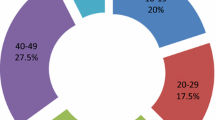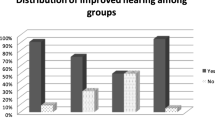Abstract
To determine the role of cortical mastoidectomy on the results of tympanoplsty in tubotympanic type of chronic suppurative otitis media. A prospective, observational, interventional study was conducted from a period of October 2006–October 2008. This included 40 patients of either sex in the age group of 15–45 years having tubotympanic type of CSOM. Tympanoplasty with mastoidectomy was done in all the patients and they were followed up for graft acceptance and hearing impairment for 5 years to see the long term results. Per-operatively, the antrum was involved in 17, aditus in 11 and middle ear in 8 patients. Incus was necrosed in 10 cases and malleus and incus were absent in a single case. Mucoid discharge was found in the middle ear in 12 out of 40 patients. Mucoid discharge ears had antral mucosal hypertrophy in 100%, blocked aditus in 75% and middle ear mucosal hypertrophy in 58% cases; ossicular necrosis in 75% cases. 90% of the cases had graft accepted. In dry ears, graft take up rate was 89% and in ears with mucoid discharge it was 92%. Average air–bone–gap reduced to 13.90 dB as compared to average air–bone–gap (Av. AB Gap1) preoperatively of 38.62 dB. After 5 years, 83.5% patients had >10 dB improvement in hearing. We recommend opening of the mastoid if on inspection of middle ear one finds mucoid type of discharge.
Similar content being viewed by others
References
Bhat KV, Naseeruddin K, Nagalotimath US, Kumar PR, Hegde JS (2008) Cortical mastoidectomy in quiescent, tubotympanic, chronic otitis media: is it outinely necessary? J Laryngol Otol 10:1–8
Mishiro Y, Sakagami M, Kondo K, Kitahara T, Kakutani C (2009) Long term effects after tympanoplasty with and without mastoidectomy for perforated chronic otitis media. Eur Arch Otorhinolaryngol 266:819–822
Diamont M (1965) The pathologic size of the mastoid air cell system. Acta Otolaryngol 60:1–10
Diamont M (1940) Otitis and pneumatization of the mastoid bone. Acta Otolaryngol 41:1–149
Flisberg K, Zsigmont M (1965) The size of the mastoid air cell system. Acta Otolaryngol 60:23–29
Austin DF (1977) On the function of the mastoid. Otolaryngol Clin North Am 10:541–547
Holmquist J, Bergstrom B (1978) The mastoid air cell system in ear surgery. Arch Otolaryngol 104:127–129
Balyan FR, Cellikkanat S, Aslan A, Taibah A, Russo A, Sanna M (1997) Mastoidectomy in noncholesteatomatous chronic suppurative otitis media: is it necessary? Otolaryngol Head Neck Surg 117:592–595
Jackson CG, Glasscock ME, Nissen AJ, Schwaber MK, Borjab DI (1985) Open mastoid procedures: contemporary indications and surgical technique. Laryngoscope 95:1037–1043
Jackler RK, Schindler RA, Francisco S (1984) Role of the mastoid in tympanic membrane reconstruction. Laryngoscope 94:495–500
Hellstrom S, Stenfors LE (1983) The original description of Sharpnell’s membrane reviewed in light of recent experimental studies. J Laryngol Otol 97:985–989
Ruhl CM, Pansak ML (1999) Role of aerating mastoidectomy in noncholesteatomatous chronic otitis media. Laryngoscope 109:1924–1927
Flisberg K, Ingelstedt S, Ortegren U (1963) The relationship of middle ear disease to mastoid hypocellularity. Acta Otolaryngol 56:69–72
Hellstrom S, Stenfors LE (1983) The pressure equilibrating function of the pars flaccid in the middle ear mechanics. Acta Physiol Scand 118:337–341
Richard SH, O’Neill G, Wilson F (1982) Middle ear pressure variation during general anaesthesia. J Laryngol Otol 96:883–892
Sade J (1992) the correlation between middle ear aeration and mastoid pneumatization. Eur Arch Otorhinolaryngol 249:301–304
Author information
Authors and Affiliations
Corresponding author
Ethics declarations
Conflict of interest
The authors declare that they have no conflict of interest.
Ethical Standards
The study was done in accordance with ethical standards. There was no funding required for the said study.
Human and Animals Rights
All procedures performed in studies involving human participants were in accordance with the ethical standards of the institutional and/or national research committee and with the 1964 Helsinki declaration and its later amendments or comparable ethical standards.
Informed Consent
Informed consent was obtained from all individual participants included in the study.
Rights and permissions
About this article
Cite this article
Garg, S., kakkar, V. Doing Mastoidectomy Along with Tympanic Membrane Repair Reduces the Need for Revision Procedures: A Prospective Study. Indian J Otolaryngol Head Neck Surg 70, 262–266 (2018). https://doi.org/10.1007/s12070-017-1177-3
Received:
Accepted:
Published:
Issue Date:
DOI: https://doi.org/10.1007/s12070-017-1177-3




